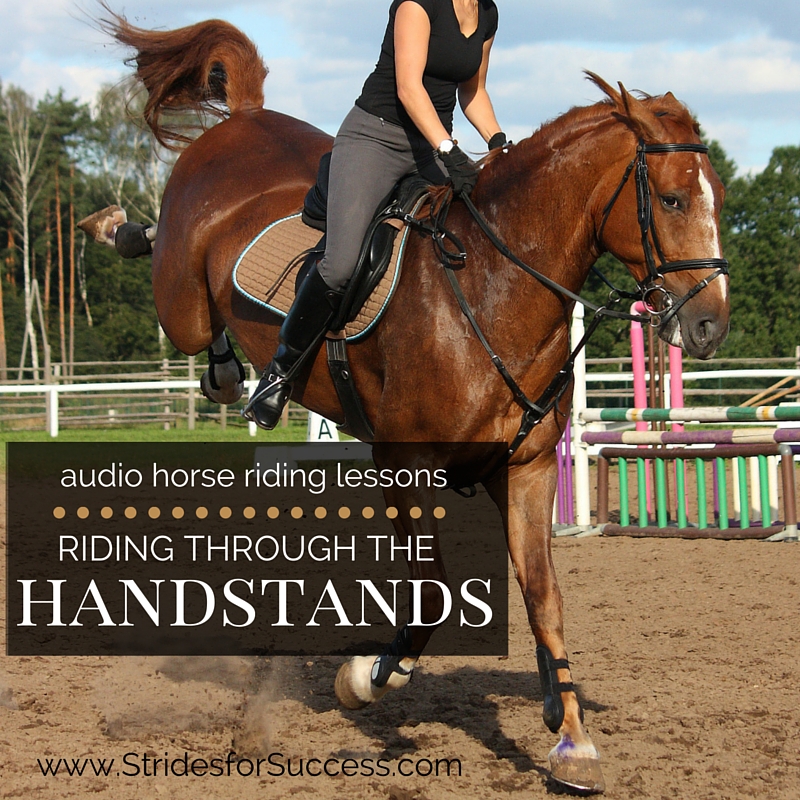Is there a feeling similar to ‘that’ feeling? The one where you’re happily riding your horse and you begin to feel that subtle lift in your horses back underneath you. This ‘up’ feeling is often accompanied by perhaps a head shake, or a swish of the tail.
You just know, with a growing sense of dread, that at any moment your usually placid and co-operative trusty steed is going transform. Your horse will demonstrate his gymnastic abilities with perfect handstands and cartwheels across the arena or field.
Think Differently?
But hold on, what would happen if you began to think a little differently about this behaviour change. Where, instead of feeling impending doom and dread, you think ‘thank you’. You can now assume that your horse is actually continuing to be his usual reliable self and is perhaps warning you of his intention. All so that you can strap on your safety belt and enjoy the ride?
Okay, probably not! But now that he has let you know, you can change the outcome.
Your actions in those few split seconds, before he begins his merry dance, have to ability to change everything. And they can become the deciding factor as to whether or not you finish the ride or get off at an earlier stop!
So, the three things that will greatly improve your chances of finishing your ride?
1. A defensive leg position
2. Keep your upper body back
3. Looking Up
So let’s have a look at these three actions one by one in a little more detail.

1. A Defensive Leg Position
When we are riding, under normal circumstances, our lower leg (below the knee) should be underneath us. Almost as though we were standing on our own two legs. Having your leg under you is one of the basics of supporting yourself and your body while you ride.
Now, if your horse suddenly decides to try his hoof at the highland fling, everything changes. When your horse’s back changes position, from being basically horizontal to having a more vertical alignment, it would make sense for your lower leg to change position as well, in order to sufficiently support you in this new, if fleeting, position.
The trick is to ‘assume’ this new lower leg position before your horse changes his.
Of course, it almost goes without saying but let’s just mention it to be sure, this all hinges on you keeping your heels down. This is certainly not the time to be a ballerina on your tippy toes, trust me!
2. Keep Your Upper Body Back
There are three reasons that this is a vital key to staying in the saddle and making the super glue work. The first one is that you will use your abdominal muscles to brace against the momentum your horse will create when he bucks. Having a strong core is extremely helpful here. However, even if you are not as buff as you wish you were, there are things you can do.
Simply rocking slightly back on your pelvis and opening your chest will activate those muscles. This will help keep your body in alignment when the buck happens.
The second reason this that you want to get your horse’s head up as soon as possible. When your horse bucks, he is using his body like a catapult; front end down, back-end up. Often with the sole purpose of flinging his ‘load’ somewhere.
If you can get the front end up, odds are that the back-end will go down.
The third reason is that when you use your core, in addition to having a slightly forward lower leg position, from the side you will look like a ‘tug of war’ participant mid match. If we visualize an actual tug of war competition, we can see that by keeping this stance, they are using their whole body, not just their arms.
This is what you want to do, brace your whole body, not just your arms against your horse.
3. Look Up
It sounds so simple. And it’s probably the last thing you think of doing! But this simple measure may be the difference between hitting the dirt and riding your horse through a buck. When you look up, you naturally keep your shoulders open and back. You also help your balance by looking at something in the distance.
The other advantage of looking up is to see where you can send your horse to distract him. This allows you to ride him through and out of the bucking spree. Simple but so effective.
Practicing Your Riding Skills
So, there you have it, the next time your horse decides to show you just how athletic he can be, you know what to do.
-
-
-
- Get your lower leg forward
- Brace your core muscles by tilting slightly back
- Look up.
-
-
The quickest way to end the performance is to get his head up and ride him forward into something different. Strangely, this is one of those things that, if you can keep those three points in mind, it actually is not such a big deal anymore at all.
Have you ever had any ‘hair raising’ experiences on your horse while riding? We would love to know what happened and how you dealt with the situation. Make sure you join our free online community for riders HERE and tell us all about it. Oh, and remember to include the outcome :)
Happy Riding
Lorna
